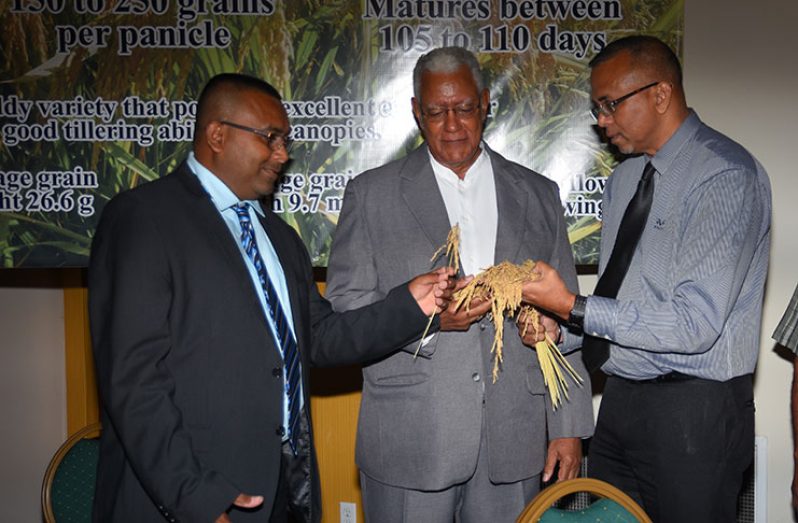…as GRDB releases new variety
THE Guyana Rice Development Board (GRDB) on Thursday released a new and improved paddy variety called “GRDB 15” and Minister of Agriculture Noel Holder noted that farmer’s receipts for paddy sold to millers in 2017 stood at G$30.2 Billion, an increase of $4.4Billion from 2016.
The minister was at the time speaking at the Pegasus Hotel where he gave the feature address during the officially release of the paddy to farmers in attendance.
Also present were General Manager of GRDB Nizam Hassan and his Deputy Allison Peters; Chief Scientist Dr. Mahendra Persaud; President of the Rice Producers Association (RPA) Leekha Rambrich, amongst other heads of departments at the Agriculture Ministry.
He said that Guyana’s rice industry is a dynamic force in the nation’s economy and has been able to create a rapid and positive change in the fortunes of the nation’s farming community and Guyana’s economy as a whole.
Minister Holder said that the release of this new high yielding variety, builds on the results of continuing research at the Rice Research Station at Burma.
The GRDB, he said, is constantly searching for and incorporating, new varieties and technology to improve the productivity of rice farming in Guyana. From 1997 to 2015, the researchers have released varieties, including one aromatic variety.
He noted that the release of these varieties has resulted in significant increases in productivity over the last decade: From 3.8 tonnes/hectare (24 bags/acre) in 2000, to 5.5 tonnes/hectare (35 bags/acre) in 2017.

“It is my understanding, that with the release of this latest variety, Guyana’s rice farmers will have the potential of realising yields of up to eight tonnes per hectare; provided that the recommended agronomic practices are incorporated, from land preparation all the way through to harvest,” Minister Holder said.
He said proper pest and disease management through an integrated approach will guarantee a positive result everytime, not only with this new variety but with all varieties being cultivated.
“The rice sector is an important industry in Guyana. Rice is the largest user of agricultural lands, over 87,000 hectares being currently double cropped and absorbs and influences a major section of the agriculture working population…as it contributes 20 per cent to agriculture GDP, 3.25 per cent to the national GDP, and accounts for more than US $200M in export earnings,” he said.
Adding that over the last decade, rice production has been growing in leaps and bounds, moving from 298,125mt ( metric tonnes) in 2007 to 630,104mt in 2017, Minister Holder said this represents a 111 per cent increase in production.
He noted that the first crop harvest this year currently stands at 394,116 mt (as at April 23, 2018) representing 75 per cent of total acreage to be harvested. It is expected that this first crop figure will top out at 530,000mt, approximately 35,000mt more than the targeted production.
What this means, he said, is that farmers are applying fertilisers and instituting pest and disease control measures as recommended in the right quantity per acre, at the right time.
“They have been using quality seed paddy at the recommended rate, they have also incorporated efficient monitoring for pests and diseases. This has contributed to a yield of 6.01 tonnes harvested so far for this first crop,” Holder said.
Underscoring that Guyana is a net exporter of rice, the minister said currently the country export to 34 countries/markets. Some of these markets include: Mexico, Portugal, Jamaica, Italy, Panama, Holland, Trinidad, etc.
In the last year, Mexico, Panama and Cuba have become important players in the nation’s foreign earnings. He explained that the GRDB 15 is a high-yielding variety, which provides more bags per acre, which translates into increased income for farmers. “As you are aware, lodging is the bending over of the stems near the ground in grain crops which makes them very difficult to harvest and can dramatically reduce yield. Lodging affects rice and reducing it is a major goal of rice research. The variety also has a strong tolerance to lodging, better milling recovery and a five per cent more yield when compared with other varieties, meaning millers too will increase their incomes,” the Agriculture Minister told farmers.
He added that the ultimate goal of nearly all the ministry does is aimed at reducing the poverty, while increasing incomes. “With this new variety on board we expect the national production to increase considerably. At $3,000 per bag, moving from 37 bags per acre to 47 bags per acre minimum, that’s an additional $30,000 per acre, which is equivalent to a 27 per cent increase,” he said.
Asserting that it is anticipated that with the launch of this new variety Guyana’s rice farmers will be producing significantly more paddy per acre, Minister Holder said his ministry has been looking at interventions in areas along the Corentyne Coast and the Canje basin that would result in some 150,000 acres of lands being opened up.
Meanwhile, Chief Scientist/ Plant Breeder Dr. Mahendra Persaud said the GRDB 15 has an early duration of 105-110 days, and the semi-dwarf paddy possesses excellent early vigor with good tilling ability and canopies very early.
He said that the strong and thick stem coupled with slow leaf senescence contribute positively to its ability to tolerate lodging. Persaud noted that the variety produces an excellent long slender grain with higher milling yields, compared to other varieties in the industry which makes it desirable for international trade.
He explained that it is foreseen that this variety will be a good economic choice for farmers as there will be rapid expansion of acreage across the country.




.jpg)








